Do-it-yourself ventilation of the barn: types of systems, air exchange rates + system arrangement
Have you ever had a situation on the farm when, with a balanced diet and warm conditions of keeping the cows, they began to give less milk sharply or did the quality of such milkings deteriorate significantly? Agree, not a very pleasant situation. Especially if animals start to get sick for no apparent reason.
For the productive content of cattle, the room must have a stable microclimate with proper air circulation. High humidity and temperature changes are most often the causes of a decrease in the amount of milk and loss of live weight. This situation can be corrected if the exhaust system is correctly designed and installed.
In the article we will tell you how to do ventilation of the barn with your own hands. Consider the existing types of exhaust systems and talk about how to choose equipment for them.
The content of the article:
Barn ventilation functions
Usually cowsheds are made of reinforced concrete slabs. Such designs are quickly erected; they are strong and durable. Along with the advantages, concrete structures also have a number of drawbacks: lack of air circulation, which is why it is stuffy inside the building in summer and cold in winter.
Cow waste provokes the formation and accumulation of ammonia. If there is no circulation of air masses, then the gas accumulates, and its high concentration can harm animals. In such an environment, bacteria multiply faster. Caustic vapors corrode the mucous membranes, causing dry mouth, as well as pain in the eyes.
Poor conditions of detention lead to a decrease in the immunity of cattle and losses to the farmer. Therefore, for any barn, as well as for chicken coop or other premises for keeping animals and birds, a ventilation system is required. It removes carbon dioxide and provides an influx of fresh air without forming drafts.
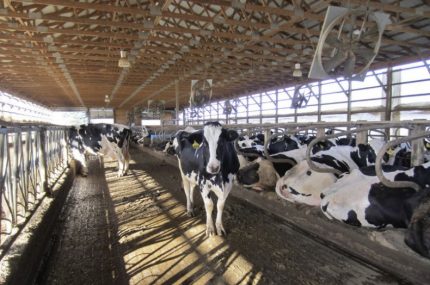
Types of ventilation systems for cattle
There are several variations of ventilation: forced, natural, as well as mixed. The choice of the exhaust system depends on the size of the structure, the number of livestock, climate characteristics and other factors.
It is comfortable for cows to exist if the area in the room for one individual is at least 6 m² and the ceiling height is from 2.5 m. There should also be an area for females with calves and a place for equipment.
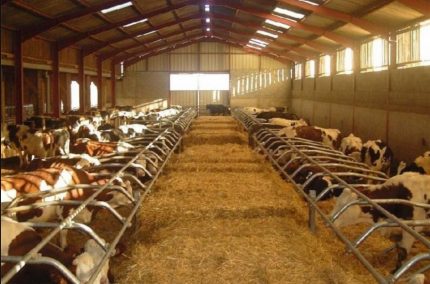
The ventilation requirements for cowsheds are given in SNiP 2.10.03-84. The document spells out the basic requirements and calculation formulas for equipment selection. Fulfilling the requirements of SNiP, the farmer will create comfortable conditions for keeping animals. The better the cows feel, the more milk they give.
All types of ventilation systems have their own characteristics of operation and installation. Improper ventilation or improperly positioned equipment can cause microclimate disturbances. Exhaust equipment should not cause drafts.
Next, we consider in more detail the features of various types of ventilation.
View # 1 - The Natural System
Fresh air is supplied through windows, slots and door structures. Exhaust moist air is discharged through the ceiling.
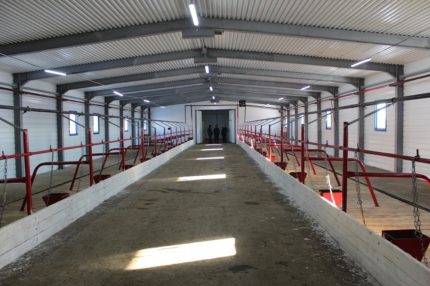
The advantages of natural ventilation include low construction costs and easy installation. Despite the absence of additional energy costs, such an exhaust system has several disadvantages.
Cons of natural ventilation:
- difficult to calculate power;
- it is impossible to adjust the humidity level;
- the presence of stagnant zones;
- pulling dust and bacteria through open windows;
- the dependence of the indoor climate on the weather.
Use of this type of ventilation is permissible only in private households and farms with a small number of cows. At the same time, the livelihoods of cows need to be removed on time or there will be little sense from the natural ventilation system.
It is possible to improve the operation of the natural exhaust system through special equipment: ventilation curtains, light horse. Additional devices will improve the process of inflow and outflow of air.
Cow ventilation shades
The product may have a rigid, semi-rigid or soft construction. Management curtains can be automatic, manual, as well as mixed. Such structures are installed on various areas of the barn: windows, doors, roof, as well as walls.

Curtains can be made of various materials. The most commonly used synthetic plastic variations. Some types of paintings are designed to completely shade the barn. There are also products that in the closed position transmit sunlight.
Advantages of ventilation curtains:
- protection of the barn from environmental influences;
- the ability to adjust the width of the opening of the canvas and create the required air flow;
- allow you to create climatic zones inside the overall premises;
- can be used to create a thermal barrier.
Optimally ventilating curtains are suitable for large-sized livestock farms.It is possible to equip the device with small cowsheds. This will allow you to quickly create comfortable conditions for keeping animals and significantly reduce energy consumption.
Light horse in the barn
The equipment is made of translucent cellular polycarbonate. Mount the skate on the roof. It improves air exchange and indoor lighting.

The device of the light ventilation ridge will protect the barn from the penetration of strong wind, rain or snow into the room. The product facilitates the natural outflow of spent moist air.
Light Skate Advantages:
- production under any type of roof is possible;
- improves the microclimate in the barn;
- protects equipment and structures from the formation of fungus;
- saves energy due to natural light;
- provides penetration of fresh air without drafts.
Polycarbonate sheets have good insulating properties. The material is resistant to abrasion and scratches. He is not afraid of temperature changes. These properties allow you to use the light skate for a long time.
View # 2 - forced ventilation
To ensure forced ventilation in the barn set fans as well as special valves. The system allows you to effectively remove excess moisture and unpleasant odors from the room. She is able to fully provide cows with fresh air.
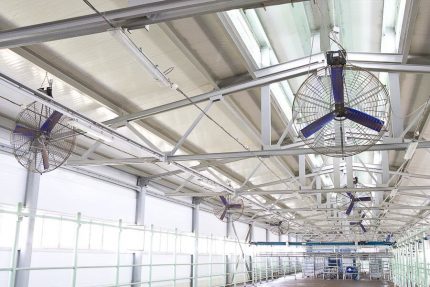
The forced ventilation equipment from the 220 V network works. The additional expenses of the system include periodic lubrication of fans and other devices, replacement of spare parts, as well as electricity costs.
The advantages of the exhaust system include:
- quick air exchange process;
- elimination of unpleasant odor;
- lack of stagnant zones;
- automation of the airing process;
- the ability to adjust the temperature.
It is difficult to independently establish forced ventilation. It is necessary to prepare a project in advance, to choose the type and power of the fan correctly. Therefore, many farmers order the installation of an exhaust system from specialists.
View # 3 - mixed ventilation system
Mixed type of ventilation is used in large cowsheds. It combines the use of automatic equipment and natural ventilation (the design of the room has many opening windows).
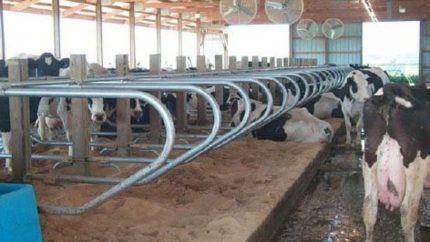
This type, in comparison with forced ventilation, can significantly reduce energy costs for conditioning the barn. Since the artificial exhaust system is connected only at lower temperatures.
Types of fans for cowsheds
For the circulation of air in large cowsheds, forced or mixed ventilation is installed. Equip such designs with various types of fans.
Types of fans:
- horizontal Ceiling
- vertical overclocking.
For exhaust systems to work for a long time, cow breeders should be made of durable and high-quality materials.
Booster fans
Such fan variations are most often used in cowsheds. They are affordable and able to create airflow along the entire room. Products are suspended at a certain angle on stretch marks.
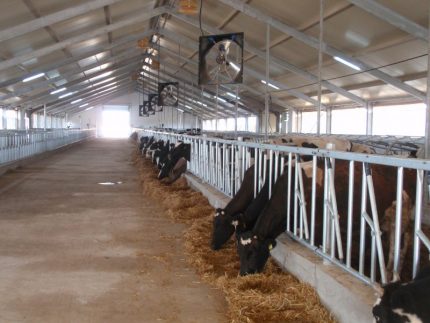
Typically, devices are placed above stalls or walkways. The height above the floor should be 2.5 m. Fans are hung in increments of 20 meters.
The fan blades are made of stainless or galvanized steel. Stainless steel has greater wear resistance due to anti-corrosion properties and high strength.
In the structure of accelerating fans there is a belt drive, which is hidden under a special cover. The engine is quite powerful, it is capable of long and continuous operation, which is especially true for regions with hot summers.
Speed control and device control is carried out through a special panel. The most expensive models of fans have a mesh or automatic shutters in their design (designed for installation in mines and openings).
Horizontal ceiling fans
Ceiling fans are installed in cowsheds with 50 or more heads. The design of the devices is quite large, the blades are able to move large flows of air masses and evenly distribute fresh air inside the structure.

Often products are used to organize a mixed type of ventilation in cowsheds. They can be mounted together with curtains or a light skate. Such fans form a constant stream of air, which contributes to the well-being of cows and calves. Lying places, as well as stalls, always remain dry. The number of microbes in the room is reduced.
Blades of exhaust products are made of lightweight and durable aluminum profile. The length of the blades depends on the area of blowing. A fan having a diameter of about 7 m is capable of providing normal airflow of an area of 22-25 m.
The control panel of the device allows you to enable or disable ventilation, as well as change the speed of rotation of the blades. A single ceiling fan can easily replace multiple vertical fans.
Barn air exchange rates
Regardless of climatic conditions, ventilation in the construction of the barn should be carried out constantly. In summer, air should be renewed more often than in the autumn-winter period.
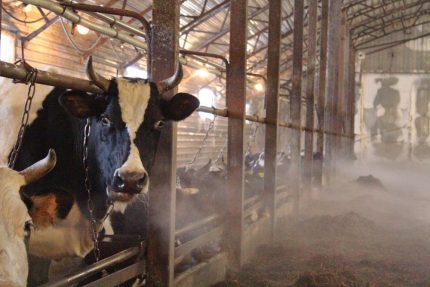
At too low temperatures, cows begin to eat a lot. But the energy received is not used to increase milk production, but to maintain body temperature.
The humidity in the barn should also be controlled. Dry air provokes rapid breathing and poorly affects the general condition of animals. High humidity promotes the growth of microbes and viruses, which contributes to various diseases.
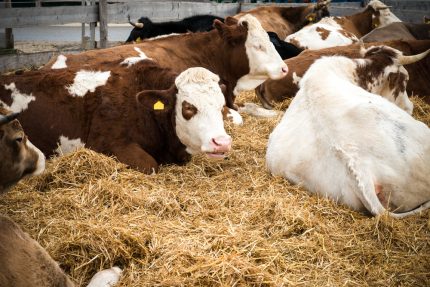
The permissible moisture content for cows is 50-85%. The optimum humidity for animal life is 70% (for all ages).
When determining the optimal air exchange in the room, a special formula is used (in this case, the combined heat and evaporation rate, adjusted for the respiration of animals, are taken into account):
L = Q x K + a / q1 - q2,
Where:
- L - the amount of air required, the volume indicator per cubic meter is calculated. m / hour;
- Q - level of evaporation;
- K - moisture that is released during the breathing of cows;
- a - moisture evaporation rate in the barn;
- q1 - an indicator of humidity of air flows indoors;
- q2 - humidity of the incoming stream.
Air exchange rate is of great importance.Especially in conditions of keeping large numbers of livestock. Because the quality and quantity of milk yield depends on it.
DIY ventilation device
Independently build an exhaust system should only be in the presence of skills and appropriate tools. Usually owners of small cowsheds are engaged in arranging natural or mixed ventilation.
First of all, in the barn, it is necessary to equip the supply air openings for fresh air from the street. They should be placed evenly along the wall at a height of 20 cm from the floor (above the foundation). Before installation, the wind rose of the area is analyzed. Equipment should be installed on the leeward side of the barn and equipped with dampers, which will allow you to adjust the intensity of the air flow.
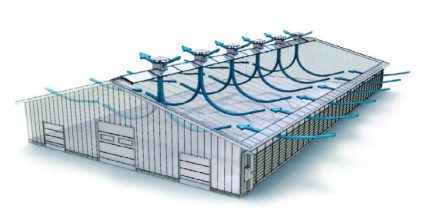
Then install ventilation ducts in the upper part of the room (at least 2 m from the floor) to remove exhaust air. For these purposes, boxes and pipes are used. They make parts from plastic, metal or wood.
We also recommend that you familiarize yourself with the features duct insulation.
To improve the flow of air masses over the entire area of the barn’s premises, a ventilation shaft is installed - a duct with a diameter of 50 × 50 cm, in which holes are made in increments of 60 cm. The shaft itself is best made of stainless steel, so it will last longer.
If ceiling fans are used, then they are mounted at an angle of 15 degrees at a height of 2.5 m from the floor covering. The distance between the units is 20 meters.
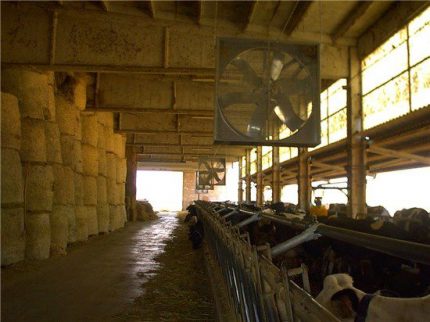
When arranging mixed ventilation, care should be taken to ensure that fans are automatically turned on / off. Since the temperature and humidity are changing, the devices will not always work with constant power.
To ensure the gradual on and off fans will help special sensors. When the temperature changes by 0.5-5 ° C, they will trigger and start ventilation. In large rooms with more than 10 fans, a step of 0.5 ° C can be set. Then, when the set temperature is reached, the units will operate alternately. Such work of devices will allow to avoid a sharp change in the microclimate.
Fan power is calculated for specific conditions of cattle. Formulas and calculation parameters are given in special regulatory documents: SNiP 2.10.03-84, Designer Handbook (section “Ventilation and air conditioning”), as well as NTP-APK 1.10.01.001-00.
But specialists are invited to design and install a forced ventilation system - installing and connecting sophisticated equipment requires skills and special tools.
Conclusions and useful video on the topic
You can see how the equipment is placed in the barn for the supply and exhaust ventilation in the video below:
In the video you can also see an example of ventilation of a small barn (up to 100 goals):
In the article, we talked about comfortable conditions for keeping animals, air exchange standards, and also examined the existing types of ventilation equipment. We analyzed the features of creating an exhaust system in the barn with our own hands.
So, the productivity of cows directly depends on the conditions of detention: ambient temperature, humidity and the presence of fresh air in the room. To create the optimal microclimate allows the ventilation system. For small cows, the natural type is suitable. Farms with a livestock of 20 individuals should be equipped with ceiling or overclocking fans.
Do you want to supplement the above information with useful information? Or would you like to tell us about your personal experience in arranging ventilation in a barn? Write your additions, share information, participate in discussions - the feedback form is located below.

 Terms and procedure for cleaning ventilation chambers and ducts: norms and procedure for cleaning
Terms and procedure for cleaning ventilation chambers and ducts: norms and procedure for cleaning  How to clean the ventilation in the apartment with your own hands: suitable tools and work procedures
How to clean the ventilation in the apartment with your own hands: suitable tools and work procedures 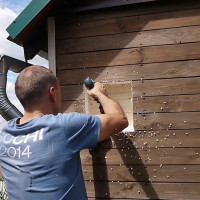 How to make ventilation in an animal shed: requirements and nuances of arranging ventilation
How to make ventilation in an animal shed: requirements and nuances of arranging ventilation  Supply and exhaust ventilation: principle of operation and features of the arrangement
Supply and exhaust ventilation: principle of operation and features of the arrangement  Supply ventilation in the apartment: options for organizing air exchange
Supply ventilation in the apartment: options for organizing air exchange  Ventilation in the wardrobe: features of the arrangement of the hood in the dressing room and wardrobe
Ventilation in the wardrobe: features of the arrangement of the hood in the dressing room and wardrobe  How much does it cost to connect gas to a private house: the price of organizing gas supply
How much does it cost to connect gas to a private house: the price of organizing gas supply  The best washing machines with dryer: model rating and customer tips
The best washing machines with dryer: model rating and customer tips  What is the color temperature of light and the nuances of choosing the temperature of the lamps to suit your needs
What is the color temperature of light and the nuances of choosing the temperature of the lamps to suit your needs  Replacement of a geyser in an apartment: replacement paperwork + basic norms and requirements
Replacement of a geyser in an apartment: replacement paperwork + basic norms and requirements